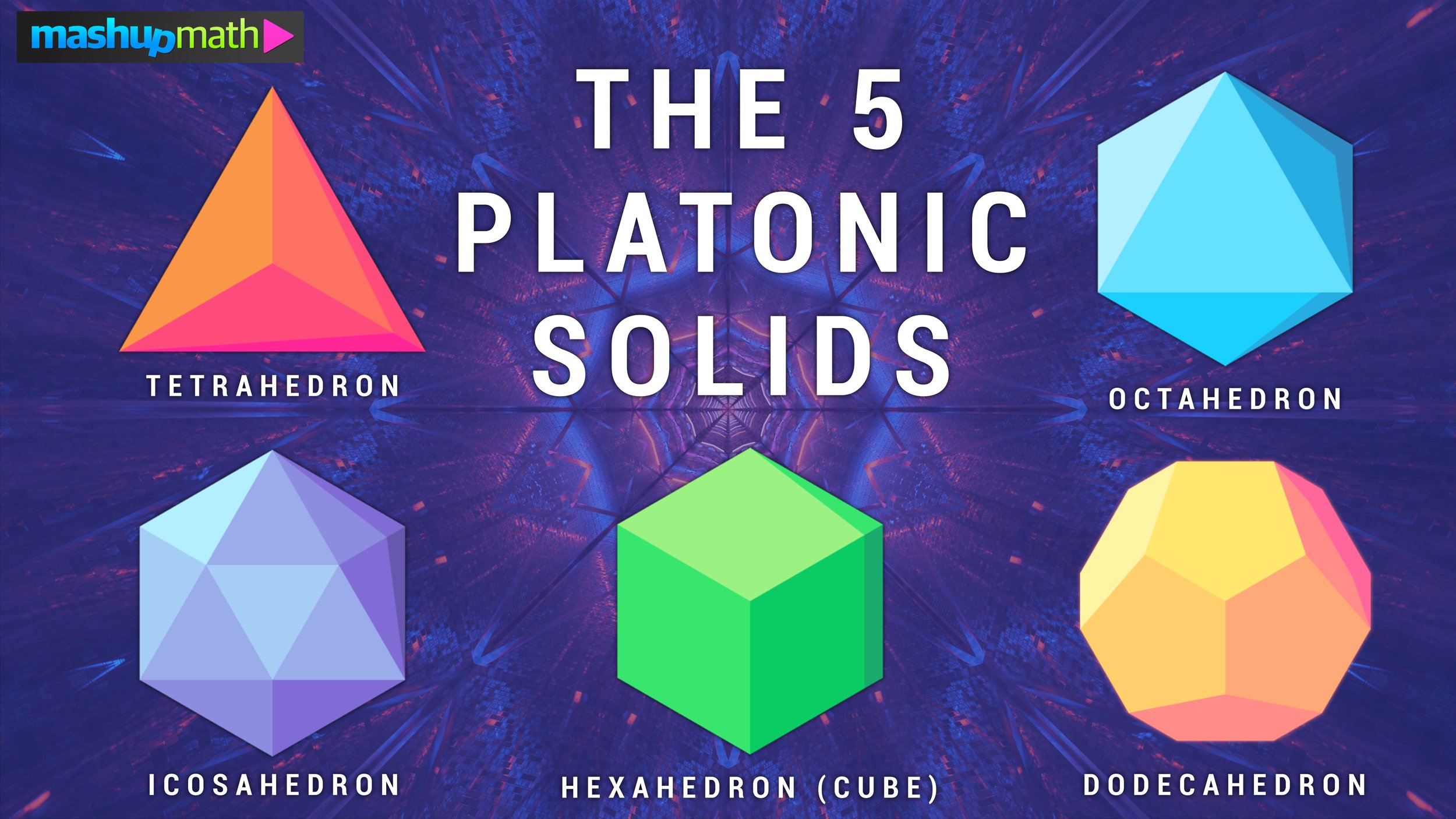The Platonic Solids Explained
The Incredible History, Meaning, and Beauty of the Platonic Solids
The 5 Platonic Solids. (Image: Mashup Math FP)
The platonic solids are incredible, timeless, and fascinating three-dimensional shapes that have been studied and admired by mathematicians and mystics for thousands and thousands of years.
The platonic solids are named after the ancient Greek philosopher Plato, who believed that these sacred geometrical figures represented the fundamental building blocks of our universe.
In this post, we will explore the history and mathematical properties of the 5 Platonic solids, as well as their significance in mathematics, science, religion, and art.
What are the 5 Platonic Solids?
There are five total platonic solids:
Tetrahedron: 4 faces, 4 points, 6 edges
Hexahedron: 6 faces, 8 points, 12 edges
Octahedron: 8 faces, 6 points, 12 edges
Icosahedron: 20 faces, 12 points, 30 edges
Dodecahedron: 12 faces, 20 points, 30 edges
The outlines of the five platonic solids. (Image: Mashup Math FP)
The History of the Platonic Solids
The history of Platonic solids can be traced back to ancient Greece, where the geometric shapes were first described by Plato in a dialogue entitled Timaeus. His interest in these geometrical figures is why they are called Platonic Solids today.
Plato believed that our universe was comprised up of five elements: earth, air, fire, water, and aether. He associated each element with a different Platonic solid. According to Plato:
The tetrahedron represents fire.
The cube represents earth.
The octahedron represents air.
The dodecahedron represents aether.
The icosahedron represents water.
Platonic Solids Elements as described by Plato. (Image: Mashup Math FP)
Plato's ideas about the platonic solids and their relationship with our universe have influenced mathematicians, mystics, and astrologists for thousands of years all the way to modern day. Notably, Plato’s writings on the 5 Platonic Solids strongly influenced the famous Roman engineer and architect Vitruvius, who wrote extensively about the use of the Platonic Solids in architectural design, as well as the Islamic scholar Al-Kindi, who dedicated his life to studying the geometrical and mathematical properties of the 5 Platonic Solids.
Platonic Solids Elements: The Platonic Solids are named after the philosopher Plato, who believed that each figure represented one of the 5 elements that make up our universe. (Image: Mashup Math FP)
Platonic Solids Sacred Geometry Relationship
Sacred geometry is a term used to describe the belief that certain geometric shapes have spiritual or divine significance. Since the Platonic Solids are believed to represent the 5 elements that make up the universe, they are considered to be a part of sacred geometry.
Furthermore, sacred geometry is often associated with the study of ancient architecture, art, and symbolism, as well as with various mystical and esoteric traditions. Proponents of sacred geometry believe that these shapes and patterns can be found throughout the natural world and can serve as a means of connecting with higher spiritual realms.
The Platonic Solids can be found in sacred geometry. (Image: Mashup Math FP)
One of the most striking features of Platonic solids is that they are all regular polyhedra. This means that each face of the solid is a congruent regular polygon, and the vertices of the solid are all congruent (i.e., identical) and equidistant from the center of the solid. In addition, the angles between the faces and the angles between the edges are all the same.
In relation to sacred geometry, the unique and universal mathematical properties of the Platonic Solids is what makes them so special—and, perhaps to some, even divine.
For example, the ratio of the length of an edge to the length of the radius of the circumscribed sphere (i.e., the sphere that passes through all the vertices of the solid) is the same for all Platonic solids. This ratio is known as the "golden ratio" and has been a subject of fascination for mathematicians and artists for centuries.
The 5 Platonic Solids Explained
How many Platonic Solids are there?
There are five platonic solids: the tetrahedron, cube, octahedron, dodecahedron, and icosahedron. Let's explore each of these shapes and their properties.
Tetrahedron
The tetrahedron is the simplest platonic solid, consisting of four equilateral triangles that meet at four vertices. Each vertex is surrounded by three other vertices, and the angles between the edges that meet at a vertex are all equal. The tetrahedron has the smallest number of faces, edges, and vertices of all the platonic solids.
Cube
The cube is probably the most well-known of the platonic solids, consisting of six square faces that meet at eight vertices. Each vertex is surrounded by three other vertices, and the angles between the edges that meet at a vertex are all right angles. The cube has a total of twelve edges, and each edge is the same length.
Octahedron
The octahedron is a three-dimensional shape made up of eight equilateral triangles that meet at six vertices. Each vertex is surrounded by four other vertices, and the angles between the edges that meet at a vertex are all equal. The octahedron has a total of twelve edges, and each edge is the same length.
Dodecahedron
The dodecahedron is a shape made up of twelve regular pentagons that meet at twenty vertices. Each vertex is surrounded by three other vertices, and the angles between the edges that meet at a vertex are all equal. The dodecahedron has a total of thirty edges, and each edge is the same length.
Icosahedron
The icosahedron is a three-dimensional shape made up of twenty equilateral triangles that meet at twelve vertices. Each vertex is surrounded by five other vertices, and the angles between the edges that meet at a vertex are all equal. The icosahedron has a total of thirty edges, and each edge is the same length.
Is there a new Platonic Solid?
While it is not classified as a Platonic Solid, there is an extremely interesting three-dimensional figure called a Buckyball that has many of the same mystical and structural properties of the Platonic Solids.
A buckyball is a type of fullerene, which is a molecule composed entirely of carbon atoms. Buckyballs are also known as C60 molecules because they are made up of 60 carbon atoms arranged in a spherical shape, like a soccer ball.
The structure of buckyballs was discovered in 1985 by scientists Robert Curl, Harold Kroto, and Richard Smalley, who were awarded the Nobel Prize in Chemistry in 1996 for their work. Buckyballs have unique electronic, optical, and mechanical properties, and they have potential applications in fields such as nanotechnology, materials science, and medicine.
If you have ever walked along the waterfront in San Francisco, California, you have likely seen the famous 25-foot Buckyball sculpture in front of the Exploratorium at Pier 15.
The famous Buckyball sculpture in San Francisco.
The structure of a Buckyball, which has faces comprised of hexagons and pentagons.
(Image: Mashup Math FP)
Conclusion: Platonic Solids
Platonic solids are special because they are a group of five regular, convex polyhedra that have the same number of faces meeting at each vertex, and all faces are congruent regular polygons.
The 5 Platonic Solids have unique mathematical properties, such as their relationship between the number of vertices, edges, and faces, as well as symmetries and interesting geometric properties that have made them the subject of study in various fields.
Additionally, their historical significance, recognized by Plato in his philosophical works, has further contributed to their divine status in the fields of mathematics and sacred geometry.
The properties of Platonic solids have fascinated mathematicians and scientists for thousands of years and continue to be a subject of study and fascination today.
More Math Resources You Will Love:
Tags: platonic solids, 5 platonic solids, elements platonic solids, platonic solids elements, platonic solids sacred geometry, five platonic solids, how many platonic solids are there, what are platonic solids



















